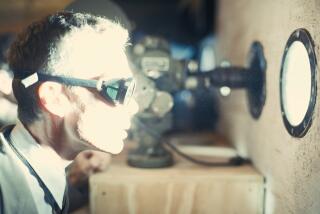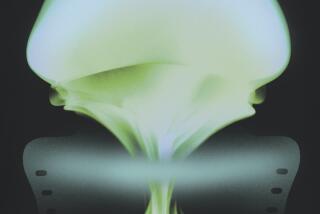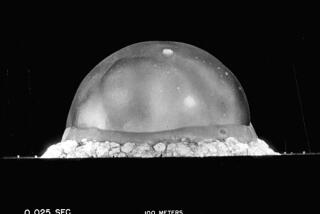Force Behind H-Bomb, ‘Star Wars’
Edward Teller, the brilliant, bushy-browed physicist who came to deplore his designation as the father of both the hydrogen bomb and the controversial “Star Wars” nuclear defense system, died Tuesday of complications from a stroke at his home on the campus of Stanford University. He was 95.
Teller died on the day he was scheduled to appear at a dedication ceremony for the University of California’s new Edward Teller Education Center, near Livermore National Laboratory.
In a remarkable career that stretched from Europe to the heart of the U.S. nuclear program, Teller deeply influenced America’s security and energy policies. A vigorous advocate of a strong national defense known (to his irritation) as “the father of the H-bomb,” he became a friend and admirer of President Reagan. But his criticism of fellow nuclear pioneer J. Robert Oppenheimer alienated many scientists. Teller himself later wrote that his criticism of Oppenheimer, in 1954, caused a permanent split in the scientific community which he felt impeded weapons research and damaged national security.
Teller’s very visible public profile also provoked criticism and satire. He was regarded by many as the model for “Dr. Strangelove,” the caricatured nuclear warmonger made famous in Stanley Kubrick’s movie. During the Vietnam era, radical anti-war demonstrators called him a “war criminal.” In 1980, an anti-nuclear protester at UCLA shoved a cream pie in his face.
His admirers were equally passionate.
“The loss of Dr. Edward Teller is a great loss for this laboratory and for the nation,” said Michael Anastasio, director of the laboratory. “He was a passionate advocate for science and the development of Lawrence Livermore National Lab. He put his heart and soul into this laboratory and into ensuring the security of this nation, and his dedication never foundered.”
Less than two months ago, Teller was awarded the prestigious Presidential Medal of Freedom, the nation’s highest civilian honor.
“In my long life I had to face some difficult decisions and found myself often in doubt whether I acted the right way,” he said after receiving the award. “Thus, the medal is a great blessing for me.”
Associate director emeritus of Lawrence Livermore and senior research fellow at the Hoover Institution at Stanford until his death, Teller despised the “father” sobriquets. He once refused to proceed with a debate at California State Polytechnic Institute until he was assured that he would not be introduced as the “father of anything.”
In a rare interview in 1988, Teller called the labels “ridiculous” and spluttered: “For heaven’s sakes, I am not! I am the father of two children. Will you please avoid this father thing?”
That may have been his longest public statement about this private man’s family: he is survived by a son, Paul and a daughter, Wendy. His wife of 66 years, Augusta Maria Harkanyi, known as Mici, died in 2000. He had four grandchildren and one great-grandchild.
If his personal life was quiet, publicly he was the most political of scientists.
He was openly obsessed with nuclear power as the source of good for energy and defensive weapons, and those unbending positions alienated many of his fellow scientists.
His presence commanded attention whether he was speaking, teaching, persuading a politician or granting a rare interview.
Writer Michael Kernan described a typical encounter in the Washington Post in 1980: “The famous brows beetled, the melancholy gray eyes bored in, the doom-laden voice set out the words one by one, like great marble blocks.”
Teller was born Jan. 15, 1908, in Budapest, Hungary, to a Jewish family. He was the son of a prosperous attorney, Max Teller, and Illona Deutch Teller. He studied at the private Mellinger School and the Minta Gymnasium in Budapest, and then enrolled in the Karlsruhe Technische Hochschule in Germany, where his father insisted he study something practical -- chemical engineering.
He also studied mathematics and became intrigued by the emerging field of quantum mechanics.
While continuing his studies at the University of Munich, Teller lost his right foot in a streetcar accident. He soon learned to walk with an artificial foot, and the handicap was almost never mentioned by Teller or anyone else.
Earning his doctorate in theoretical physics in 1930, at the age of 22, from the University of Leipzig, Teller wrote his thesis on the theory of the hydrogen molecular ion. That formed the basis for his work on the theory of the molecule, still the most commonly accepted description.
He spent the next two years as a research consultant at the University of Gottingen, but became alarmed about his career and his safety as the Nazis gained power in Germany.
“The hope of making an academic career in Germany for a Jew existed before Hitler came -- and vanished the day he arrived.... It was obvious I had to leave Germany,” Teller told biographers 45 years later.
His ticket out was a Rockefeller Foundation fellowship for a year at the University of Copenhagen. There he began to focus on nuclear physics and met Russian expatriate George Gamow, who invited him to join him as a professor of physics at George Washington University in Washington, D.C.
After a short teaching stint in 1934-35 at the University of London, Teller accepted Gamow’s invitation, teaching at George Washington from 1935 to 1941.
In 1941, the year he became a U.S. citizen, Teller was recruited to work on the Manhattan Project that created the atomic bomb. He began at Columbia University and the University of Chicago, and in 1942 joined Oppenheimer at UC Berkeley, and in 1943 moved with him to the new Los Alamos Laboratory in New Mexico.
More interested in fusion than fission, Teller was nevertheless credited with important contributions. Among them were his calculations that stymied fears that an atomic blast could actually set the oceans on fire, creating a world holocaust.
He became unhappy with Oppenheimer’s lack of interest in a “superbomb” after World War II was ended by atomic bombs on Hiroshima and Nagasaki. He left Los Alamos to teach at the University of Chicago (1946-49) but returned in 1949 as assistant director, his vision soon bolstered by President Harry S. Truman’s decision in 1950 to develop a hydrogen bomb.
One declassified account of the project, by Hans Bethe, wartime Los Alamos director of the theoretical division, has said that work proceeded on a fusion-type or hydrogen bomb in the postwar period but had been hampered by Teller’s “very incomplete” or faulty calculations.
By 1951, however, Teller had overcome a major research problem by determining that X-rays could be used to ignite the bomb’s thermonuclear fuel. The first hydrogen bomb was exploded at Eniwetok on Nov. 1, 1952.
About that time, Teller’s dream of a “second Los Alamos” was realized when the Atomic Energy Commission established Lawrence Livermore Laboratory, associated with UC Berkeley, to conduct thermonuclear research and develop nuclear weapons.
Teller was a key start-up scientist, serving as associate director (1954-58 and 1960-75) and director (1958-60). The complex of Quonset huts and low-rise office buildings east of San Francisco has frequently been referred to as “the house that Teller built.”
Always considered a jovial and intellectually stimulating teacher, Teller taught physics at Berkeley from 1953 to 1975 while he conducted his research at nearby Livermore.
Unlike many of his Los Alamos colleagues who came to rue their creation, Teller remained a staunch advocate of nuclear energy and weapons. Still, he campaigned for safe, professionally maintained nuclear power plants and argued that the reason for powerful weapons and defense mechanisms was to make war unnecessary.
But what critics forgot was that Teller was one of those who advocated warning Japan before dropping the atomic bomb.
“The man who dissuaded me from supporting it [that view] was Robert Oppenheimer,” Teller said many years later, “and one of the things for which I reproach myself was that, at that time, I let myself be persuaded by Oppenheimer.”
At a 1954 Atomic Energy Commission hearing, Teller said he considered Oppenheimer a loyal American but added, “I feel I would prefer to see the vital interests of this country in hands that I understand better and therefore trust more.”
Oppenheimer was denied a security clearance, and many scientists blamed Teller.
He remained a prolific speaker and author, writing alone or with co-authors a dozen books espousing his views as well as his research. A Library Journal review of his 1987 book, “Better a Shield Than a Sword,” noted: “The author’s viewpoints on weapons are not apt to please everyone, yet he has written in forceful terms of his views on the need for a strong defense policy as a way to prevent another war.... A controversial work that deserves reading as a stimulant for further action by an informed citizenry.”
Even after the nuclear reactor accident at Pennsylvania’s Three Mile Island in 1979, when much of the country was questioning a commitment to nuclear power, Teller continued to stress his undiminished support for nuclear energy in full-page advertisements in the Wall Street Journal, the Los Angeles Times and other newspapers, sponsored by Dresser Industries Inc. and other pro-nuclear companies.
Referring to a heart attack he had suffered after Three Mile Island, after working 20-hour days in Washington refuting anti-nuclear spokesmen, Teller stated in the advertisement:
“You might say that I was the only one whose health was affected by that reactor near Harrisburg. No, that would be wrong. It was not the reactor. It was Jane Fonda [the actress whose anti-nuclear film “China Syndrome” was in circulation at the time]. Reactors are not dangerous.”
In the late 1970s, Teller toyed with the idea of challenging California Democrat Alan Cranston for his Senate seat.
As it turned out, Teller never needed a Senate seat to wield political influence. He had broadened his political power base in 1975 when he became a senior research fellow at Stanford’s conservative Hoover Institution on War, Revolution and Peace.
And when the man he referred to as “my president,” Ronald Reagan, was elected in 1980, he had ready access to the White House.
Teller was believed to have inspired parts of Reagan’s landmark “Star Wars” speech in March 1983, calling for the expensive and controversial Strategic Defense Initiative and to have swung allocation of most of the research funds to Livermore.
Teller first got to know Reagan when he invited the new governor of California to tour Livermore in 1967, and the two men remained mutual admirers.
“He listened carefully,” Teller recalled many years later, “and he asked a number of highly intelligent questions which showed he can clearly comprehend the technology.”
Two months after the “Star Wars” speech, Reagan presented the National Medal of Science, the nation’s highest scientific honor, to Teller in a White House ceremony.
Teller was honored for his “contribution to molecular physics, understanding the origin of stellar energy, the theory and application of fusion reaction, the field of nuclear safety.”
Among Teller’s other honors over the years were the Enrico Fermi award in 1962, Israel’s Technion Institute’s Harvey Prize in 1975 and the Albert Einstein Award in 1977. He was elected to the National Academy of Sciences in 1948 and to the American Academy of Arts and Sciences in 1954. He also held a number of honorary degrees in science, law and humane letters.
In theoretical physics, Teller was recognized for contributions to the fields of molecular structure, nuclear reactions, cosmology, solid state and cosmic rays.
Then there were the critics.
Nobel Prize-winning physicist I.I. Rabi once called Teller “a danger to all that’s important” and added, “I do really feel it would have been a better world without Teller.”
Conversely, Nobel laureate Eugene Wigner referred to him as “the most imaginative person I ever met,” adding “and this means a great deal when you consider that I knew Einstein.”
And in the political arena, where Teller sought financial and moral support for his life work, the late Nelson A. Rockefeller once described him as “an individual of energy, dedication, and genius so extraordinary as to mark him indelibly on my memory and leave me eternally in his debt for the services he has rendered mankind.”






